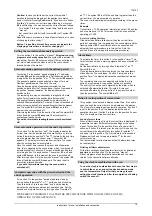
179732
Instructions for use, installation and connection
6
Energy saving tips
The bottom of the dish is too
thin and becomes crooked in the
process of heating up. The
consequence is excessive
consumption of energy and
uneven distribution of heat.
incorrect
The dish is too big or too small.
Temperature resistant glass,
protruding over the edge, might
break. Dish with too small
bottom diameter excessively
consumes energy and is not
economical.
incorrect
Adequate size of cooking
dishes.
Below are some important
suggestions how to use your
new cooker and its accessories
in order to save as much energy
as possible.
correct
Stick to the general rule:
The better the quality of the dish, the lower consumption of
energy!
Important warnings!
•
Never switch on empty hotplates, without dishes, and never
use hotplates for heating the ambience!
•
Keep the hotplates and the cookware clean, because dirt
may affect your cooking results.
•
Hot oil or grease is highly inflammable, so the
preparation of food with large quantities of oil (chips)
should be under constant surveillance at all times.
Special warning for hotplates
•
Never place wet dishes or steaming lids upon the hotplate.
Humidity may damage hotplates.
•
Never cool down hot dishes upon idle hotplates, because
condensation below the dish may cause corrosion of the
hotplate.
Operation of hotplates
Hotplates are controlled by knobs, located at the control panel.
Symbols adjacent to the knobs indicate their location.
Heating power is regulated in steps.
It is recommended to switch the hotplate off 3-5 minutes before
the completion of cooking, and use the remaining accumulated
heat.
Following are the recommended power regulations.
Express hotplate
is more powerful than the regular one, which
means that it heats up much quicker.
It is marked by the red dot in the middle, which may
disappear with time due to repeated cleaning.
Step
Suitable for
E
S
0
0
hotplate off, use of remaining heat
1-2
1
maintaining temperature, slow cooking, small
quantities of food (
min. power
)
3
2
slow cooking
4-5
3
slow cooking of large quantities, slow fryanig of
large big chunks
6
4
frying, preparing soup basis
7-8
5
frying
9
6
boiling, browning, frying
(maximum power)
Oven
Important warnings!
•
Never put aluminum foil to the bottom of the oven, and do
not place any crockery upon it. The oven enamel may be
damaged by the excessive heat.
•
Fruit juice, dripping from the baking pan, may produce stains
upon the enamel, which are very hard to remove.
Operation
Oven is controlled by the
function knob and the
temperature selection knob.
Temperature selection knob
Function knob
Modes of operation
Oven may be used in the following modes.
Oven illumination
Oven illumination may be switched on independently, without
any other function.
This may come handy during the cleaning, or when switched
off and using the remaining oven heat.
During all other oven functions the illumination is automatically
switched on with the selection of a particular function.




































